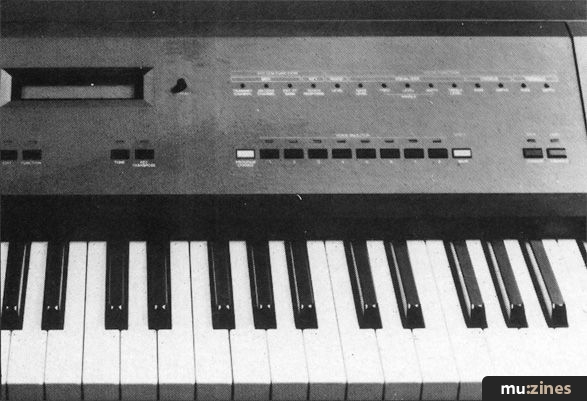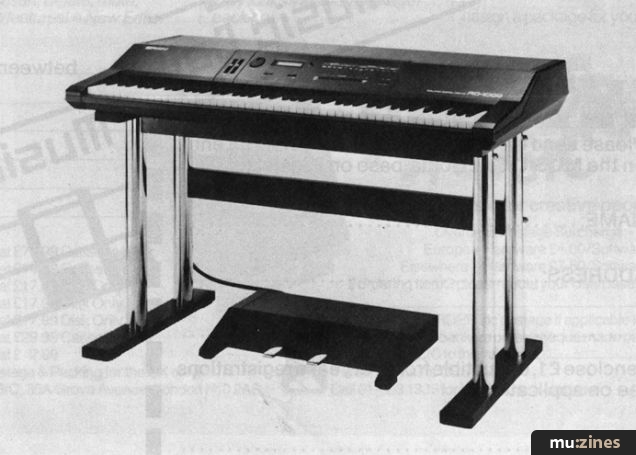Magazine Archive
Home -> Magazines -> Issues -> Articles in this issue -> View
Roland RD1000 Piano | |
KeyboardCheckArticle from International Musician & Recording World, August 1986 | |
Roland introduce the SAS and Jim Betteridge finds it makes a piano easier to yomp with.

Yes but where do you put the candelabra?
What is a piano? Will it ever be possible for an electronic device to be better than a nine foot Bosendorfer? Presumably a synth can't be better than the real thing in any absolute way, but there is little doubt in my mind that the RD1000 would be a far better thing to take on the road with you than an acoustic grand. This is because of simple considerations like it would fit in the van, you and the bassist could lift it onto the stage, it would still be perfectly in tune after you'd lifted it there and if you accidentally dropped it under a passing articulated lorry, you would only have lost £2,500 as opposed to possibly more like £15,000. 'But these are all the rather banal, uncaring questions of the Philistine mind, with no consideration spared for the intrinsic value of a truly acoustic instrument', I hear you say. But there again, what has the acoustic piano ever done for the small gigging band?
On the whole, the Pop and Rock genres have not been kind to the piano player. Though the sound of the piano has always been central to the music and more hits have been born of the black and white keys than any other instrument, for the keyboard player on the road, the piano has always been a headache. He may be armed with dozens of digital and analogue synths, but unless he's rich there'll be no wooden weighted action with a real piano sound at the end of it. So it is with open arms that I welcome the RD1000.
The RD1000 is one of a new generation of electronic pianos that actually sound like... pianos! It has an 88-note, touch sensitive wooden keyboard with a delightfully weighted action not unlike a light concert grand. It offers eight voices: two acoustic grands, an electro-acoustic (such as the Yamaha CP80 or similar Kawai models), harpsichord, clavinet, vibraphone, and two electric pianos that sound not at all unlike an older and a new Fender Rhodes. These eight voices are stored permanently in internal ROM and can be recalled in their virgin state at any time. They can also be used as a basis for editing although it is important to realise that this is not a synthesiser and so the changes that can be made are largely of a, for want of a better term, 'secondary' nature; ie they could be effected by external processors. Having made your alterations, your own set-ups can be stored for instant retrieval in a further 56 internal memory locations.
In the effects department there are separate chorus and tremolo facilities each with adjustable rate and depth. Roland always have been good at chorus effects ever since they invented the stuff, and both these effects are of a high quality.
Where one might be lucky to find a treble and bass control on an older model, the RD1000 incorporates a three band equaliser with parametric mid, which is for all intents and purposes a complex set of tone controls. The fixed treble and bass controls are there and allow you to cut and boost their respective frequency bands by a reasonable 10.5dB. The middle section is unusually sophisticated, however, and when they say it's parametric they actually do mean parametric as opposed to simply sweepable. In addition to the ±10.5dB gain control and the facility to choose the centre of the band of frequencies you wish to affect, between 400Hz and 4,000Hz, you can also adjust the width of the frequency band (the 'Q') to produce a variety of different tonal effects — a very valuable tool when you're trying to recreate a specific piano sound, especially because we are generally so sensitive to inaccuracies with piano voicings.
A separate overall volume can be set for each of the 56 memorised sounds meaning that if you want to go from playing soft chords to taking a piano solo, you can store the two relative volumes in the appropriate memories so that they are there as part of the preset as soon as you select it. One of the most important factors with an electronic piano, and one of the most difficult to replicate, is that of touch response. On the RD1000 there are four degrees of this: 'A', 'B', 'C' and 'D'. It has to be said that, on the review model anyway, the differences between these settings was 'subtle'. It was not so tricky to tell 'A' from 'D', but 'A' from 'B' definitely left a few blank looking expressions on the faces of those present at the testing — mine included. It must be borne in mind that the machine under review was a pre-production unit, and so it could just be that this will be changed for the final production units. For £2,500 I think it's a reasonable request and a wider span of touch responses would be very useful for inexperienced players or for when you are required to play fast parts repeatedly whilst maintaining an even touch, and also for hammering out endless rhythmical Rock chords.
Though equipped, this could not be described as a 'mother keyboard'. You can decide which channel to send and receive on, but there is no keyboard split and although there is a manual facility to send programme change instructions to a remote MIDI instrument as a separate operation, there is no facility to make programme changes on the RD1000 automatically result in a programme change on the remote instrument. This is not altogether satisfactory especially considering that there are 64 memories in which a whole gig's worth of combinations could have been stored.

The RD1000 can assign MIDI channel, but no split information
The Sounds
With Roland's recent entry into the sampling keyboard market, you might have thought that they would have been using sample sounds for the RD1000, but no. They are derived through a new method of synthesis developed by Roland which they are calling 'Structured/Adaptive Synthesis' or SAS for short. Precise technical details of what the process entails don't seem to be readily available at present, but it is apparent that samples of real instruments are taken for analysis and then some form of digital re-synthesis takes place. The results are certainly very good, and the noise level is brilliantly low as compared to some of its rivals. Apparently, each note has 128 uniquely contoured degrees of touch response for both volume and tone, which provides a generally smooth and satisfying feel.
Both the piano voicings have the feel of an acoustic grand, though the first voice is somewhat rounder and less rocky than the second, which would be great for driving rhythm work. They are both very satisfying to play, however. The third piano sound is basically a replacement for the Yamaha CP80 or the Kawai electric grand. Until recently there have been no alternatives, but I do think that we'll being seeing less of these and more electronic instruments from now on. The harpsichord is also very convincing with a limited touch response offerings good compromise between the real thing, which of course has none, and the demands of the modern (spoilt) keyboard player. Though the 'Clavi' sound is referred to in the brochure as the 'clavi net', it is a brassier and rounder sound, and in fact, not at all unpleasant. When played softly it actually sounds rather more like a clavichord.
The vibraphone voicing is also very good offering a bright, full sound getting progressively harder and edgier as you play harder. Then there are the two electric pianos, the first of which has a full, round sound with a dirty distorted edge when played hard. The second voicing is a thinner sound with less distortion and more tone as you play harder. Both are very good and equally usable in their own ways. Once again Roland have incorporated their now famous Alpha Wheel for editing and in this situation where there are only a limited number of parameters to change, it works very well indeed. It is greatly helped by the large backlit LCD screen which keeps you informed as to which sound/variable/value you are dealing with.
The insides of the RD1000 are also available in expander (no keyboard) form at a relatively reasonable £1200. If the sleek grey, roadworthy appearance of the RD1000 is not your cup of tea, you can get the home version in Rosewood or Walnut for £2200 and £2400 respectively, although you then lose the editing/memory facilities.
Conclusion
I'd still much prefer the real thing for playing in my front room, but for live work and quick reliable studio performances, the RD1000 is excellent. Whether the balance of price and facilities is right for you as compared to other models on the market (ie Yamaha and Technics) is a matter for your own consideration. But this certainly has a lot going for it.
Roland RD1000 RRP: £2,500 (approx)
Also featuring gear in this article
Structured Sound - Roland RD1000 Piano
(EMM Sep 86)
The Shape of Pianos to Come
(IM Jun 86)
Browse category: Piano > Roland
Featuring related gear
Publisher: International Musician & Recording World - Cover Publications Ltd, Northern & Shell Ltd.
The current copyright owner/s of this content may differ from the originally published copyright notice.
More details on copyright ownership...
Review by Jim Betteridge
Previous article in this issue:
Next article in this issue:
Help Support The Things You Love
mu:zines is the result of thousands of hours of effort, and will require many thousands more going forward to reach our goals of getting all this content online.
If you value this resource, you can support this project - it really helps!
Donations for April 2024
Issues donated this month: 0
New issues that have been donated or scanned for us this month.
Funds donated this month: £7.00
All donations and support are gratefully appreciated - thank you.
Magazines Needed - Can You Help?
Do you have any of these magazine issues?
If so, and you can donate, lend or scan them to help complete our archive, please get in touch via the Contribute page - thanks!









